I don’t know when strawberry ice-cream started to disappear from freezers, but I suspect some of the blame can be laid at the door of “a couple of old hippies from Vermont”, as the Daily Mirror described Ben and Jerry on the brand’s entry into the UK market back in the mid-1990s. Fruit flavours, it seemed, were out, chocolate cookie dough and nut butter crunch were in, and, 30 years later, it’s surprisingly hard to find a tub of plain old strawberry. In fact, just such a fruitless mission inspired this week’s quest. It’s a shame, too: in my book, all ice-cream is good ice-cream, but there’s something particularly joyful about a pink quiff of strawberry ice: British summer in a sticky, dripping cone. Happily, it’s a lot easier to make than it is to track down in shops.
The fruit

Ripe strawberries, even overripe ones, are vital here, because the low temperature and high fat content required by the recipe both have a muting effect on flavour. Given that good berries tend to be expensive, even when they’re in season, heed pastry chef Anna Higham’s heartfelt request, in her book The Last Bite: “Please don’t just slice off the top of the fruit”. Hull them, cutting around the leaves and removing just the hard white core underneath, so you waste as little as possible.
Higham starts by gently heating fruit with sugar to make a juice, which she calls her “secret ingredient … to bump up the flavour in any strawberry dish”. The recipes in David Lebovitz’s The Perfect Scoop, Joe Trivelli’s The Modern Italian Cook and Kitty Travers’ La Grotta Ices kick off similarly, though, instead of making a separate batch of juice, they simply macerate the fruit with sugar to draw the juices out of the berries, thereby creating a syrup. According to Lebovitz, who also adds a slug of vodka or kirsch, “macerating the strawberries beforehand magically transforms even so-so berries into fruits that are brilliantly red”.
This is certainly less work than making juice, which endears it to me, though the recipe in The Book of St John (prefaced by the bold statement: “We are certain that we have achieved strawberry ice-cream perfection”) skips the macerating stage altogether in favour of simply pureeing the strawberries with melted sugar, and it tastes great, too.
However, fruit can vary wildly, so it’s safer to macerate it first – and, though this may be entirely imagined, some of my testers judge the fruit flavour in Higham’s and Travers’ ices to be more complex and fragrant than the competition. Up to you.
I don’t happen to mind a few strawberry pips, or even small chunks of flesh, in my ice-cream – not least because it adds to the impression that you’re eating a product with some relation to actual fruit – but if you have a more refined palate, push the puree through a sieve before mixing with the dairy, as Travers recommends.
The dairy

The higher the fat content of an ice-cream, the smoother and creamier the result will be, which is why it’s hard to make a satisfying, low-fat example without recourse to industrial additives. On the other hand, lower-fat formulas often have a fresher, more intense flavour, a fact confirmed by Trivelli’s gelato recipe, which is made using slightly more whole milk than double cream, and is thickened with cornflour. Travers’ ice-cream is similar, albeit thickened with egg yolks rather than flour, which gives a denser, richer result, while Lebovitz uses almost equal parts of soured and double cream for a tangy, delicately fruity flavour profile.
The oldest recipe I try, from Mrs AB Marshall’s 1885 Book of Ices, calls for whipping cream beaten to soft peaks – or at least so says the version of the recipe that’s printed in Caroline and Robin Weir’s masterful Ice Creams, Sorbets and Gelati: The Definitive Guide; the one in my copy of Marshall’s book specifies custard or cream. It’s also the only one I don’t use an ice-cream maker for, so it’s distinctly icier than the others – if you don’t have one available, Higham tells me her recipe can be made no-churn by whipping the cream and condensed milk before folding in the blended strawberries and sugar, which feels a better bet.
The recipe in question mixes double cream with condensed milk in a ratio of roughly 3:1; the milk’s lower water content providing creaminess without the deadening effect of extra fat, because it’s just 9% as opposed to double cream’s 48%-plus, which gives the fruit more of a chance to shine than in the wonderfully luxurious St John version that uses pure double cream.
Frankly, though testing strawberry ice-cream has a real “it’s a tough job, but somebody’s got to do it” vibe, this week has been hard simply because people don’t tend to be at their critical best when confronted by freshly made ice-cream. “I like all of them,” is not a helpful way to differentiate between six tubs of pure pink pleasure. However, on the basis that I want a clean strawberry flavour (rather than anything too rich, which will distract from the fruit) and a smooth, creamy texture, I’ve gone for a combination of double cream and condensed milk. (Note that if you’d prefer a plant-based recipe, Higham’s book has one made with oat milk.)
The flavourings
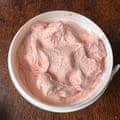
Marshall uses vanilla sugar and Trivelli soft brown, but, apart from the condensed milk, which has a distinct, white-chocolate character of its own, this dish should be all about the strawberries, so I’ve stuck to ordinary white stuff (caster or granulated), plus a pinch of salt.
Lebovitz and St John both add lemon juice, while Travers uses “frozen redcurrants or a good tangy redcurrant jelly”, which, she says, “will improve the texture of this ice-cream and give it body – since strawberries can tend to be watery, even in peak season”. Though they are indeed over 90% water, I find these additions actually improve the taste, too. They bring out the naturally acidic notes of the fruit, just as sugar amplifies its sweetness, and yield an ice-cream that tastes of fresh strawberries, rather than the cloying, artificial kind. Lemon juice dissolves more easily, so I’ve gone for that, but feel free to use a tablespoon of redcurrant jelly instead.
The temperature

Thoughresearch is yet to show any credible evidence for the idea that maturing your ice-cream base overnight is key to success, it should be properly chilled before you begin to freeze it, because this will speed up the process, and so give a better final texture. (I suspect this gives the flavours more time to infuse, but, again, that’s just a hunch.) Do remember that without stabilisers to keep the water locked in, homemade ice-cream will last only about a week in the freezer before it becomes unpleasantly hard; it will also need to come out of the freezer a little before you intend to eat it, just like in the old days.
Perfect strawberry ice-cream
Prep 10 min
Macerate 2 hr+
Chill 1 hr+
Churn 30 min+
Makes About 1 litre, to serve 8
500g ripe strawberries, hulled
150g white sugar
50ml lemon juice
350ml double cream
150ml condensed milk
A pinch of salt
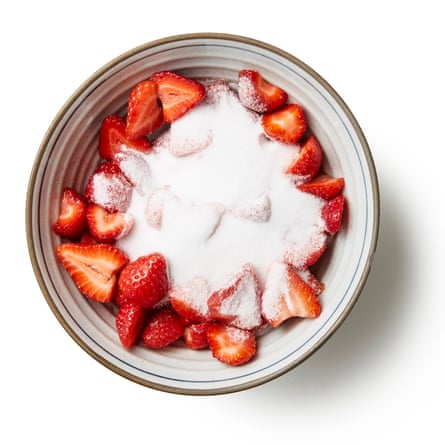
Cut the hulled strawberries in half, then put in a bowl with the sugar and lemon juice, and stir until the fruit is well coated.
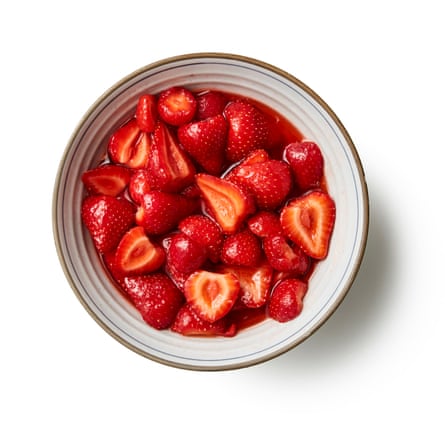
Cover and leave to steep for at least two hours, and longer, if possible, until the strawberries are sitting in bright red juice.
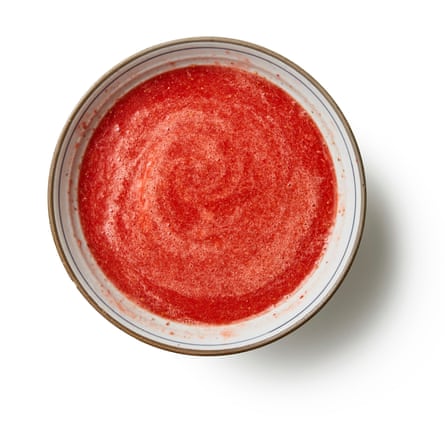
Puree the fruit, leaving a few small chunks if you like…
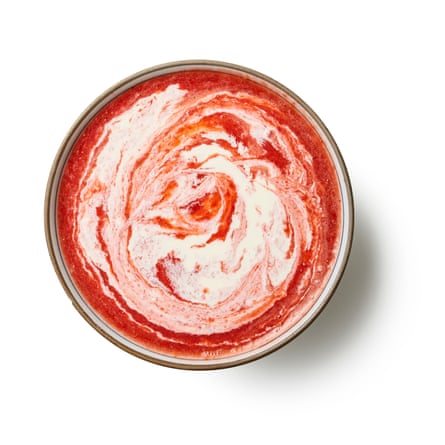
… then add the cream, condensed milk and salt. Stir well, then chill thoroughly for at least an hour.
Churn the mixture in an ice-cream machine and serve at once.
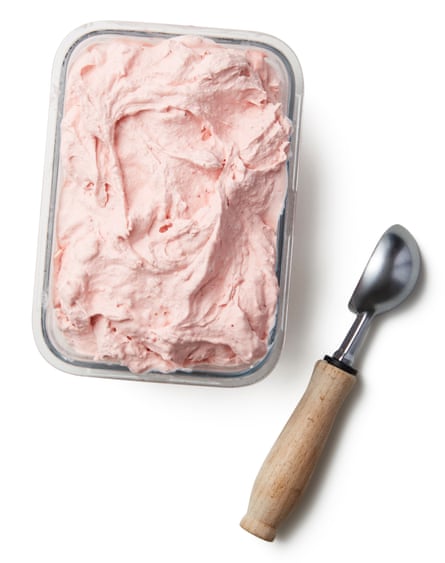
If you’d prefer a harder texture, decant the churned ice-cream into a container, press clingfilm on the surface to eliminate any air bubbles and freeze for an hour or so. Eat as soon as possible for maximum enjoyment.
-
Can anyone solve the mystery of the disappearing strawberry ice-cream for me – or am I, in fact, imagining it? If so, who makes the best?
https://ift.tt/VyuYMTC
Entertainment
No comments:
Post a Comment